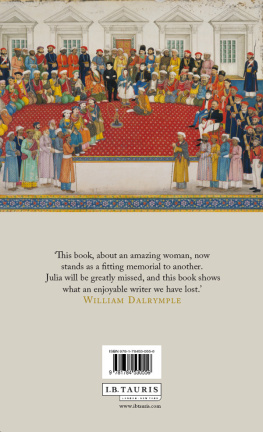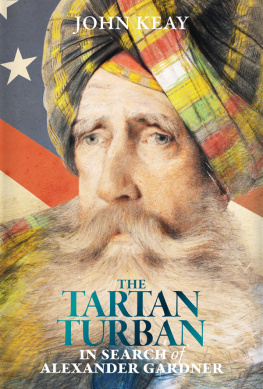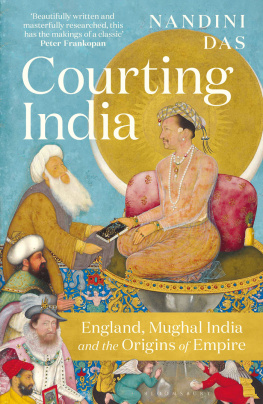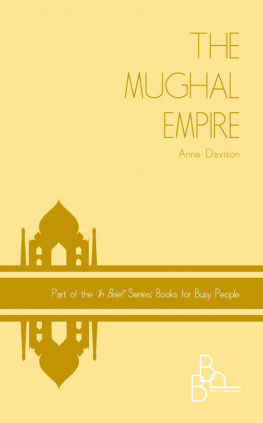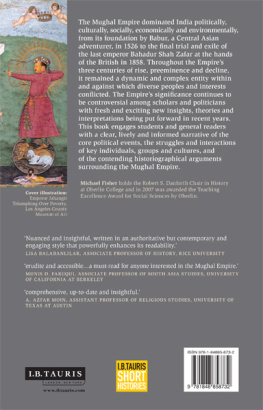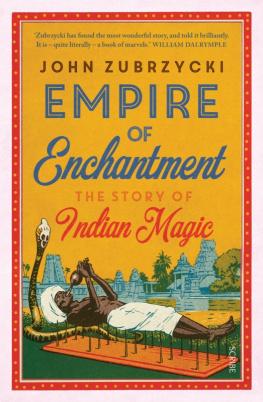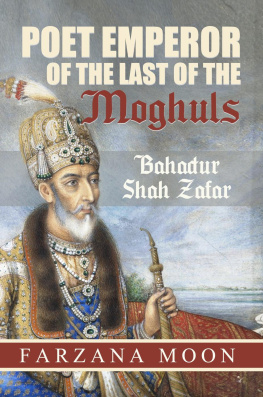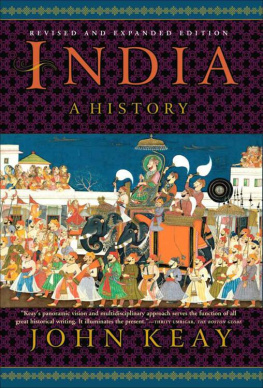JULIA KEAY was the author of several acclaimed biographies including The Spy Who Never Was, With Passport and Parasol and Alexander the Corrector. She also wrote numerous BBC radio documentaries, including two plays, and, with her husband John Keay, co-edited two editions of the Encyclopaedia of Scotland and the third edition of The London Encyclopaedia. The text of Farzana was completed just before her death in 2011.
This book, about an amazing woman, now stands as a fitting
memorial to another. Julia will be greatly missed, and this book
shows what an enjoyable writer we have lost.
William Dalrymple
A delight to read.
Charles Allen, Literary Review

New hardback edition published in 2014 by I.B.Tauris & Co Ltd
6 Salem Road, London W2 4BU
175 Fifth Avenue, New York NY 10010
www.ibtauris.com
Distributed in the United States and Canada Exclusively by Palgrave Macmillan
175 Fifth Avenue, New York NY 10010
First published in India in 2013 by HarperCollins Publishers India
Copyright 2014 the Estate of Julia Keay
Copyright Foreword 2013 William Dalrymple
The right of Julia Keay to be identified as the author of this work has been asserted by the Estate of Julia Keay in accordance with the Copyright, Designs and Patents Act 1988.
All rights reserved. Except for brief quotations in a review, this book, or any part thereof, may not be reproduced, stored in or introduced into a retrieval system, or transmitted, in any form or by any means, electronic, mechanical, photocopying, recording or otherwise, without the prior written permission of the publisher.
ISBN: 978 1 78453 055 6
eISBN: 978 0 85773 569 0
A full CIP record for this book is available from the British Library
A full CIP record is available from the Library of Congress
Library of Congress Catalog Card Number: available
CONTENTS
PART ONE: MARRIED TO THE REGIMENT
17501778
PART TWO: DAUGHTER OF THE EMPEROR
17781788
PART THREE: THE ONLY LADY AT THE TABLE
17881836
FOREWORD
I n the first fifty years of the eighteenth century, Delhi and its region was transformed from one of the richest and grandest capitals of the world to an insecure battle zone, disputed by rival warlords, depopulated by half a century of massacres, and looted by a succession of brutal marauders. It was, however, still full of reminders of the magnificence of its past.
The approach to the city set the tone. For miles in every direction, half collapsed and overgrown, robbed and re-occupied, tottering and disintegrating, neglected by all, lay the remains of six hundred years of Indian imperium. Hamams and palaces, thousand pillared halls and mighty tomb towers, empty mosques and semi-deserted Sufi shrines: there seemed to be no end to the litter of ages, the vanity projects of a hundred forgotten sultans, the products of the piety of a thousand long-dead Sheikhs. The prospect towards Delhi, as far as the eye can reach is covered with the crumbling remains of gardens, pavilions, mosques and burying places, wrote Lieutenant William Franklin in 1795. The environs of this once magnificent and celebrated city appear now nothing more than a shapeless heap of ruins
It was a similar scene inside the city walls. The mansions of the nobles were larger than the city palaces of any European nobles, but they lay in a state of terminal disrepair and untended, were collapsing on every side. In the palace itself, the greatest treasures of the Red Fort had all been removed by Nadir Shah in 1739; fifty years later, in the summer of 1788, the marauder Ghulam Qadir personally blinded the Emperor, and then threw vinegar in the wounds by carting off his fabulous library (most of which he then sold to the Nawab of Avadh, much to the Emperors fury). The costumes of the court were threadbare and the precious stones had been picked out of the pietra dura work of the Imperial apartments. A blind emperor ruled from a ruined palace; most of the talented poets and artists had fled to Lucknow (with the single important exception of the mystic poet Mir Dard). Only those too old or decrepit or impoverished to leave remained.
Nor was it just the travellers who looked with sadness at this vast crumbling necropolis. Delhi-wallahs, particularly those who remembered better days, wept at the fate of their ransacked city: How can I describe the desolation of Delhi, asked the poet Sauda. There is no house from which the jackals cry cannot be heard. The mosques at evening are unlit and deserted. In the once beautiful gardens, the grass grows waist-high around fallen pillars and ruined arches.
It was in this Delhi, and on its Doab outskirts, that the Begum Sumru of Sardhana presided over one of the most fascinatingly hybrid courts in India. The Begum was originally said to have been a part-Kashmiri dancing girl whose rapid rise to fortune began when she became the bibi of a German soldier of fortune in Mughal service, Walter Reinahrdt known as Sombre (Indianized to Sumru) after his severe expression.
When the Mughal Emperor Shah Alam gave Reinhardt a large jagir [or estate] north of Delhi, Reinhardts Begum went with him and turned the village of Sardhana into their capital, with a ruling class drawn both from Mughal noblemen and a ragged bunch of over 200 neer-do-well French and Central European mercenaries, many of whom converted to Islam and took Muslim names. After Sombres death, his begum ruled in his stead, partly from Sardhana, and partly from her large palace on Chandni Chowk. She converted to Catholicism while continuing to cover her head in the Muslim manner and appealed direct to the Pope to send a chaplain for her court. By the time the intriguingly named Father Julius Caesar turned up in Sardhana, her plans to build the largest church in northern India were already well advanced.
The culture of the Begums circle mixed European and Mughal custom to an extraordinary extent: so much so that at least three of the Begums European mercenary officers became poets in Urdu one, whose pen name was Farasu, turned out to be the son of a German Jewish soldier of fortune Gotlieb Koine by a Mughal princess; he was included in the list of prominent Urdu poets produced by the former principal of Delhi College, Alois Sprenger, while according to another contemporary critic this unlikely poet left behind him a camel load of poetic works
The three-day-long Christmas festivities at Sardhana would be opened by High Mass, and during the following two days a nautch and a display of fireworks during which the Sardhana poets had an opportunity for reciting their verses
The way that the Christian converts at Sardhana continued doggedly to keep to their old Mughal customs was not to everyones taste: as Fr Angelo de Caravaggio, the Capuchin who followed Julius Ceasar put it: My four years at Sardhana saw the construction of a church and a house. Since I was unable to bring about the abandonment of Muslim customs, and seeing no chance of improvement, I took the decision to devote myself to the education of children seeing that despite my efforts, Christianity did not affect the customs of the Muslims, I [eventually] returned to Agra with the children..
This fusion of civilisations could sometimes be confusing. The Begum was not alone in crossing cultures at this period. Her fellow Mughal jagirdar, the American-born William Linnaeus Gardner, had married a Shia Begum of Cambay, while his son James had married Mukhtar Begum, a first cousin of the Emperor Bahadur Shah Zafar. Together they fathered an Anglo-Mughal dynasty, half of whose members were Muslim and half Christian; indeed some of them, such as James Jahangir Shikoh Gardner, seem to have been both at the same time. In 1820, Gardners Begum came to Delhi to negotiate a marriage alliance between her dynasty and that of the Begum Sumru, using the British Resident in Delhi, Sir David Ochterlony as intermediary: I believe James [Gardners eldest son] is to be contracted at the next Ede, wrote William Gardner to a cousin,
Next page
